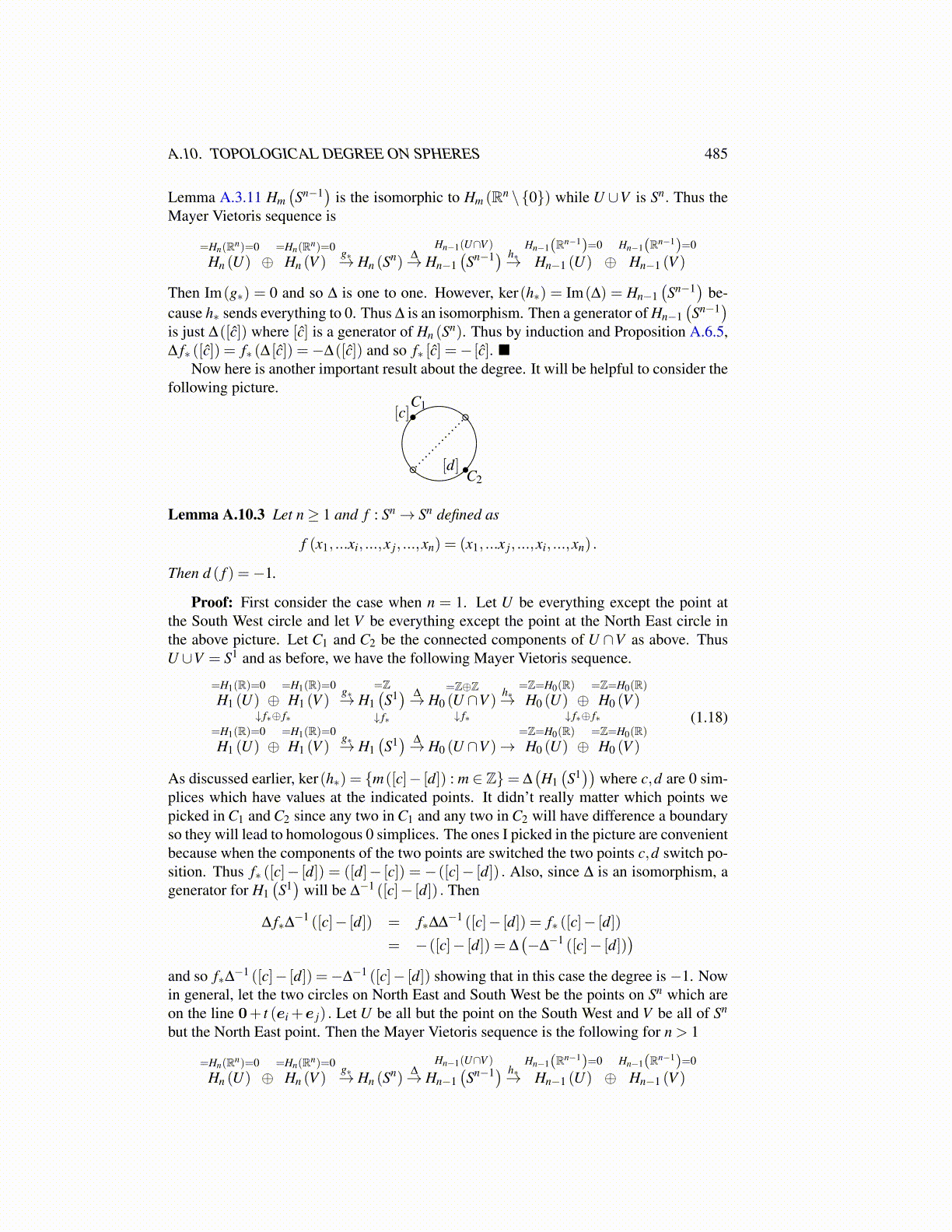
A.10. TOPOLOGICAL DEGREE ON SPHERES 485
Lemma A.3.11 Hm(Sn−1
)is the isomorphic to Hm (Rn \{0}) while U ∪V is Sn. Thus the
Mayer Vietoris sequence is
=Hn(Rn)=0Hn (U) ⊕
=Hn(Rn)=0Hn (V )
g∗→ Hn (Sn)∆→
Hn−1(U∩V )
Hn−1(Sn−1) h∗→
Hn−1(Rn−1)=0
Hn−1 (U) ⊕Hn−1(Rn−1)=0
Hn−1 (V )
Then Im(g∗) = 0 and so ∆ is one to one. However, ker(h∗) = Im(∆) = Hn−1(Sn−1
)be-
cause h∗ sends everything to 0. Thus ∆ is an isomorphism. Then a generator of Hn−1(Sn−1
)is just ∆([ĉ]) where [ĉ] is a generator of Hn (Sn). Thus by induction and Proposition A.6.5,∆ f∗ ([ĉ]) = f∗ (∆ [ĉ]) =−∆([ĉ]) and so f∗ [ĉ] =− [ĉ]. ■
Now here is another important result about the degree. It will be helpful to consider thefollowing picture.
[c]
[d]
C1
C2
Lemma A.10.3 Let n≥ 1 and f : Sn→ Sn defined as
f (x1, ...xi, ...,x j, ...,xn) = (x1, ...x j, ...,xi, ...,xn) .
Then d ( f ) =−1.
Proof: First consider the case when n = 1. Let U be everything except the point atthe South West circle and let V be everything except the point at the North East circle inthe above picture. Let C1 and C2 be the connected components of U ∩V as above. ThusU ∪V = S1 and as before, we have the following Mayer Vietoris sequence.
=H1(R)=0H1 (U) ⊕
=H1(R)=0H1 (V )
↓ f∗⊕ f∗
g∗→=Z
H1(S1)
↓ f∗
∆→=Z⊕Z
H0 (U ∩V )↓ f∗
h∗→=Z=H0(R)H0 (U) ⊕
=Z=H0(R)H0 (V )
↓ f∗⊕ f∗=H1(R)=0H1 (U) ⊕
=H1(R)=0H1 (V )
g∗→ H1(S1) ∆→ H0 (U ∩V )→
=Z=H0(R)H0 (U) ⊕
=Z=H0(R)H0 (V )
(1.18)
As discussed earlier, ker(h∗) = {m([c]− [d]) : m ∈ Z}= ∆(H1(S1))
where c,d are 0 sim-plices which have values at the indicated points. It didn’t really matter which points wepicked in C1 and C2 since any two in C1 and any two in C2 will have difference a boundaryso they will lead to homologous 0 simplices. The ones I picked in the picture are convenientbecause when the components of the two points are switched the two points c,d switch po-sition. Thus f∗ ([c]− [d]) = ([d]− [c]) = −([c]− [d]) . Also, since ∆ is an isomorphism, agenerator for H1
(S1)
will be ∆−1 ([c]− [d]) . Then
∆ f∗∆−1 ([c]− [d]) = f∗∆∆−1 ([c]− [d]) = f∗ ([c]− [d])
= −([c]− [d]) = ∆(−∆−1 ([c]− [d])
)and so f∗∆−1 ([c]− [d]) =−∆−1 ([c]− [d]) showing that in this case the degree is−1. Nowin general, let the two circles on North East and South West be the points on Sn which areon the line 0+ t (ei +e j) . Let U be all but the point on the South West and V be all of Sn
but the North East point. Then the Mayer Vietoris sequence is the following for n > 1
=Hn(Rn)=0Hn (U) ⊕
=Hn(Rn)=0Hn (V )
g∗→ Hn (Sn)∆→
Hn−1(U∩V )
Hn−1(Sn−1) h∗→
Hn−1(Rn−1)=0
Hn−1 (U) ⊕Hn−1(Rn−1)=0
Hn−1 (V )